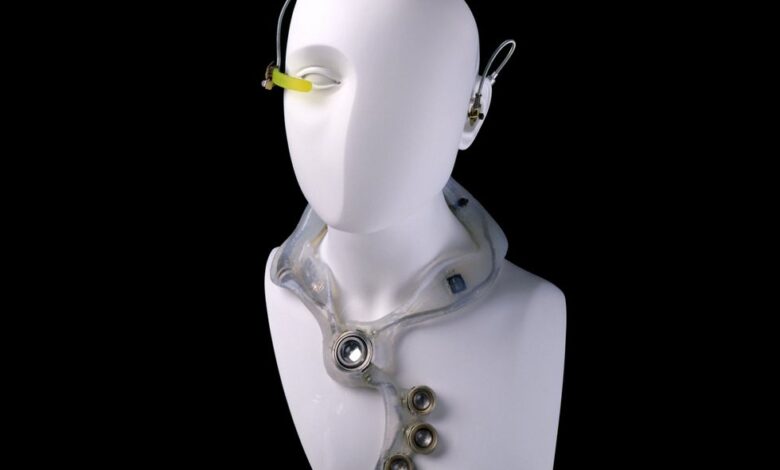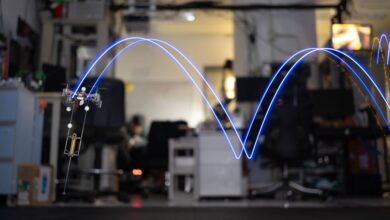This Wearable Computer Made a Fashion Statement

In 1993, well before
Google Glass debuted, the artist Lisa Krohn designed a prototype wearable computer that looked like no other. The Cyberdesk was an experiment in augmented reality. At a time when computers were mostly beige and boxy, Krohn envisioned a pliable, high-tech garment that fused fashion with function.
Krohn studied art and architectural history at Brown University and the
Rhode Island School of Design (RISD) before completing an MFA at Cranbrook Academy of Art in Bloomfield Hills, Mich., in 1988. With the Cyberdesk, she tapped into a cultural moment in which artists, techies, writers, and others were celebrating the convergence of humans and machines and eagerly anticipating our cyborg future.
What is Lisa Krohn’s Cyberdesk?
Although a working prototype of the Cyberdesk was never built, the yellow eyepiece suggested a retinal display.Lisa Krohn and Christopher Myers
The Cyberdesk, made of resin, plastic, metal, and glass, was meant to be worn like a necklace. The four circles along the breastbone are a four-key keyboard with a large trackball at the top center; the user would use the keyboard and trackball to make selections from menus of options. A small microphone lies against the throat, and an earpiece hooks into the left ear. Krohn imagined the yellow tube in front of the right eye as a retinal scan display that would project a laser beam directly onto the back of the eye, creating a screen centered in the user’s field of vision. In the back, there is a port suggestive of some type of neural link. The Cyberdesk was intended to run on energy harvested from the body’s movement and the sun.
A port on the back of the Cyberdesk was intended as a neural link.Lisa Krohn and Christopher Myers
Krohn, along with Chris Myers, a student at the Art Center School of Design, made two models of the Cyberdesk, but it was never turned into a working prototype. The underlying technology wasn’t there yet, although there were engineers who were experimenting with similar ideas. For example, Krohn knew about work on virtual retinal displays at the University of Washington’s Human Interface Technology Laboratory, but she didn’t pursue a collaboration.
And so Krohn’s design existed as “strategic foresight, speculative technology, predictive design, or design fiction,” she told me in a recent email. Krohn imagined a possible future, one in which, as she notes on her company’s website, “person and machine merge into one seamless collaborative super-being!” In other words, a cyborg.
The Cyberdesk wasn’t the only piece of cyborg gear that Krohn designed. In 1988, before the age of smartphones and Web searches, she imagined a
wrist computer that combined satellite navigation, a phone, a wristwatch, and a regional information guide. Made of a flexible plastic, it could be folded up and worn as a decorative cuff when not being used as a computer.
Lisa Krohn also designed a flexible wrist computer that could be folded up when not in use. Lisa Krohn
Krohn designed the wrist computer prototype before “wearable” became a common way to refer to a portable device that incorporates computer technology. Futurist
Paul Saffo is credited with first using the term “wearable computer” in an article in InfoWorld in 1991. Saffo predicted the first wearables would be worn on the belts of maintenance workers and then be extended to deskless, information-intensive tasks, such as conducting store inventories. He also suggested a game console consisting of a tiny display integrated into sunglasses and paired with a power glove. Nowhere did he consider technology as a fashion accessory, and I suspect he wasn’t even considering women when he made his predictions.
Meanwhile,
Steve Mann was working on ideas for mediated vision as a graduate student at MIT. Mann was first inspired to build a better welding mask that would protect the welder’s eyes from the bright electric arc while still allowing a clear view. This led him to think about how to use video cameras, displays, and computers to modify vision in real time. Both Krohn and Mann ran into similar real-world challenges: cellphones, the Internet, civilian GPS, and online databases were still in their infancy, and the hardware was heavy and clunky. While Mann built boxy functional prototypes that he demoed on himself, Krohn imagined more speculative technology.
Each “page” of the Krohn’s phonebook represents a separate function—dial phone, answering machine, and printer. Lisa Krohn, Sigmar Willnauer, and Tony Guido
Krohn also worked on utilitarian business technologies. In 1987, she designed a prototype for the
phonebook, an integrated phone with answering machine and printer. Each “page” of the phonebook had its own function, and an electric switch automatically changed to that function as the page was flipped, with instructions printed on the page. That intuitive design was in sharp contrast to most answering machines of the time, which were clunky and not particularly easy to use.
The phonebook was an example of “product semantics,” which holds that a product’s design should help the user understand the product’s function and meaning. At Cranbrook, Krohn studied under
Michael and Katherine McCoy, who embraced that theory of design. Krohn and Michael McCoy wrote about that aspect of the phonebook in their 1989 essay “Beyond Beige: Interpretive Design for the Post-Industrial Age”: “The casting of [a] personal electronic device into the mold of [a] personal agenda is an attempt to make a product reach out to its users by informing them about how it operates, where it resides, and how it fits into their lives.”
Lisa Krohn championed cyberfeminism and cyborgs
Lisa Krohn designed the Cyberdesk in 1993, at a time when wearable computers existed mainly in science fiction.
Dietmar Quistorf
The Cyberdesk as well as the wrist computer were early examples of designs influenced by cyberfeminism. This feminist movement emerged in the early 1990s as a counter to the dominance of men in computing, gaming, and various Internet spaces. It built on feminist science fiction, such as the writings of Octavia Butler, Vonda McIntyre, and Joanna Russ, as well as the work of hackers, coders, and media artists. Different threads of cyberfeminism developed around the world, especially in Australia, Germany, and the United States. While mainstream depictions of cyborgs continued to tilt masculine, cyberfeminists challenged the patriarchy by experimenting with genderless ideas of cyborgs and recombinants that melded machines, plants, humans, and animals.
The feminist theorist and historian of technology
Donna Haraway kindled this cyborgian drift through her 1985 essay, “A Manifesto for Cyborgs,” published in the Socialist Review. She argued that as the end of the 20th century approached, we were all becoming cyborgs due to the breakdown of lines dividing humans and machines. Her cyborg theory hinged on communication, and she saw cyborgs as a potential solution that allowed for a fluidity of both language and identity. The essay is considered one of the foundational texts in cyberfeminism, and it was republished in Haraway’s 1990 book, Simians, Cyborgs, and Women: The Reinvention of Nature.
Krohn imagined a possible future, one in which “person and machine merge into one seamless collaborative super-being!” In other words, a cyborg.
Krohn and McCoy’s 1989 essay also highlighted communication as a central problem in modern design. Mainstream consumer electronics, they argued, had reached a monotonous uniformity of design that favored manufacturing efficiency over conveying the product’s intended function.
Both Haraway and Krohn saw opportunities for technology, especially microelectronics, to challenge the restrictions of the past. By embracing the cyborg, both women found new ways to overcome the limits of language and communication and to forge new directions in feminism.
Cyberdesk 2.0
I had the privilege of meeting Lisa Krohn when she participated in a roundtable on the Cyberdesk at the 2023 annual meeting of the
Society for the History of Technology. The assembled group, which included curators and conservators from the Cooper Hewitt, Smithsonian Design Museum and the San Francisco Museum of Modern Art (each of which has a Cyberdesk prototype in its collection), considered a possible Cyberdesk version 2.0. What would be different if Krohn were designing it today?
In 2023, Krohn reimagined the Cyberdesk. It now incorporates technology that hadn’t been available 30 years earlier, such as sensors to monitor brainwaves, hydration, and stress levels.Duvit Mark Kakunegoda
The group focused their discussion around the idea of “design futuring,” a concept promoted by Tony Fry in his 2009 book of the same name. Design futuring is a way to actively shape the future, rather than passively trying to predict it and then reacting after the fact. Fry describes how design futuring could be used to promote sustainability.
In the case of the Cyberdesk 2.0, a focus on sustainability might lead to a different choice of materials. The original resin provided a malleable material that could mold to the contours of the body. But its long-term stability is terrible. Despite best practices in conservation, the Cyberdesk will likely turn into a goopy mess in the not-too-distant future. (In a previous column, I wrote about a
transistorized music box owned by John Bardeen that suffers from the same basic problem of decaying materials, which in curatorial circles is known as “inherent vice.”)
The panelists considered alternatives like biomaterials, and they discussed the entire product life cycle, the challenges of electronic waste, and the mining of rare earth elements. They wondered how the design process and the global supply chain might change if such factors were considered from the start, rather than as problems to be solved later.
These are just a few of the ideas that percolated while historians, artists, curators, and conservators considered the Cyberdesk. Now imagine if a few engineers were also present. To me, that would have been a really worthwhile discussion. Not only can art unlock creative design and push innovations in new directions, it also allows us to reflect on technology in daily life. And artists can learn from engineers about new materials, technologies, and possibilities. Working together, technology and design no longer need the modifiers speculative and predictive. Engineers and artists can create the future reality.
Part of a continuing series looking at historical artifacts that embrace the boundless potential of technology.
An abridged version of this article appears in the July 2024 print issue as “The Wearable Computer as Bling.”
References
I first learned about Lisa Krohn’s Cyberdesk and design theory at the Society for the History of Technology’s conference in Los Angeles in 2023, during the session “Revisiting Lisa Krohn’s Cyberdesk (1993), a cyberfeminist concept model.”
Both the Cooper Hewitt, Smithsonian Design Museum and the San Francisco Museum of Modern Art have featured their respective Cyberdesks in exhibits and online articles. Note that the difference in the colors—SFMOMA’s is white, while Cooper Hewitt’s is brown—is due to the instability of the plastics and resin, as well as variations in the materials.
As I considered Krohn’s cyborg designs, I couldn’t help but recall Donna Haraway’s classic essay “A Cyborg Manifesto,” a foundational text in cyberfeminism. Forty years on, we are more cyborgian than Haraway originally posited. Her challenges to traditional notions of identity still resonate with today’s nuanced discussions of gender. Addressing algorithmic bias and generative AI training may be a new frontier for cyberfeminism.
IEEE Spectrum




